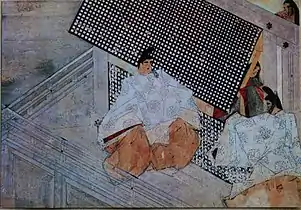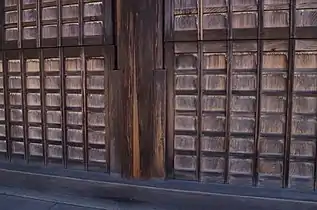
Shitomi. To open, the top half is hooked up. In this type, the bottom half is lifted out (here, it is leaned up against the closed shitomi alongside). Note hooks, both empty and in use, dangling from eaves.
Shitomi (蔀), also called hajitomi (半蔀) are square-lattice shutters or doors found on older-style Japanese buildings. They are characteristic of the Shinden style,[1][2] and the Heian Period (794-1185).[3] They were used in aristocrats' palaces, and more rarely occur in temple buildings.[3] They were replaced by sliding panels in the Shoin style.[4]
They are usually split and hinged horizontally; when open, the upper shutter was held up at 90 degrees to the wall with hooks, and the lower half could either be lifted out or folded parallel to the upper shutter.[1] This makes it possible to take down the entire wall and just leave the pillars.[3] They are occasionally referenced in modern architecture.[5][6][7]
Extant examples
Gallery
 Hook for suspending upper half.
Hook for suspending upper half. Shitomi, with only the top half opened. There are shōji behind.
Shitomi, with only the top half opened. There are shōji behind. Hajitomi are split, and hinged, horizontally. Center, the bottom half has not been lifted out. There are yukimi shōji behind the hajitomi.
Hajitomi are split, and hinged, horizontally. Center, the bottom half has not been lifted out. There are yukimi shōji behind the hajitomi. Part-opened hajitomi, 1200s. Note round pillars.
Part-opened hajitomi, 1200s. Note round pillars. Closed, showing how lower half must be lifted out.
Closed, showing how lower half must be lifted out. Vertically-hinged shitomi, or folding doors, might be used in a corner. 1309; some highly decorated sliding panels in the interior, green sudare elsewhere.
Vertically-hinged shitomi, or folding doors, might be used in a corner. 1309; some highly decorated sliding panels in the interior, green sudare elsewhere. Lower shutters from central three bays (inter-pillar spaces) have been lifted out and stacked against the outermost bays
Lower shutters from central three bays (inter-pillar spaces) have been lifted out and stacked against the outermost bays
See also
Wikimedia Commons has media related to Shitomi (shutters).
References
- 1 2 "Shitomido 蔀戸". JAANUS.
- ↑ "Japanese Architecture". Encyclopedia of Japan.
- 1 2 3 4 "Hajitomi: Latticed Shutters". Ninna-ji Temple Official English Blog. Ninna-ji Temple. 29 April 2011.
- ↑ Lao, Todd. "Shoin Features: Undeveloped Elements". www.columbia.edu.
- ↑ "House in Shitomido". leibal.com.
- ↑ "Paper Art Museum Shigeru Ban Architects". German-Architects.
- ↑ Magazine, Wallpaper (22 October 2014). "The architecture projects reshaping Japan". Wallpaper*.
- ↑ "Ujigami Shrine, Uji's Hidden Shrine - Kansai Odyssey". kansai-odyssey.com.
- ↑ "Osaka Temmangu Shrine".
This article is issued from Wikipedia. The text is licensed under Creative Commons - Attribution - Sharealike. Additional terms may apply for the media files.
